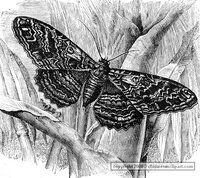Moth
|
|
| Moths | ||||||||
|---|---|---|---|---|---|---|---|---|
 Emperor Gum Moth | ||||||||
| Scientific classification | ||||||||
|
A moth is an insect closely related to the butterfly. Both are of the order Lepidoptera.
People who study butterflies and/or moths are called lepidopterists; the study of butterflies is known as butterflying, and the study of moths mothing, the latter giving rise to the term mother for someone who takes part in this activity - sometimes written with a hyphen inserted: moth-er - to distinguish it from the word for a female parent (in spoken English, confusion does not arise as the two are pronounced differently).
The division of Lepidoperans into moths and butterflies is a popular taxonomy, not a scientific one. Sometimes the names "Rhopalocera" (butterflies) and "Heterocera" (moths) are used to formalise the popular distinction.
Most species of moths are nocturnal, but there are crepuscular and diurnal species. They can be distinguished from butterflies in several ways.
| Contents |
Economic significance of moths
Moths, and more particularly their caterpillars are a major agricultural pest in many parts of the world. The catepillar of the Gypsy moth causes severe damage to forests in North East USA, where it is an exotic species. The Codling moth also does extensive damage, especially to fruit farms.
Other moths are commonly regarded as pests because their larvae eat fabric such as clothes and blankets made from natural fibres such as wool. They are less likely to eat mixed materials containing artificial fibres. There are some reports that they can be repelled by the scent of wood from juniper and cedar, by lavender or by other natural oils. However, many consider this unlikely to prevent infestation. Naphthalene (the chemical used in mothballs) is considered more effective, but there are concerns over its effects on health. Freezing items infested with moth larvae will not kill them.
Moths are sturdy and usually require larger amount of pesticide to kill them than mosquitos or flies.
Other moths are farmed. Especially the Silkworm (the larva of a moth) is farmed for the silk with which it builds its coccoon. The silk industry produces over 130 million kg of raw silk, worth about 250 million US dollars worldwide.
Attraction to light
Moths are apparently attracted to light, or more specifically, are known to circle bright objects. The reason for this behaviour is not known. It may be moths navigate by maintaining a constant angular relationship to a bright celestial light (such as the moon), but on encountering a bright artificial light it navigates maintaining a constant angle to the light resulting in the moth flying in a spiral until it hits the light source.However, researchers such as Henry Hsiao suggest the reason for moths circling lights has to do with a visual distortion called a Mach band. Henry Hsiao conjectures that moths, as nocturnal creatures, fly towards the darkest part of the sky in pursuit of safety. Moths are thus inclined to circle ambient objects in the Mach band region, usually at a radius of about one foot, depending on the species.
Night blooming flowers usually depend on moths (or bats) for pollination, and artificial lighting can draw moths away from the flowers, impacting the plant's ability to reproduce. Light pollution is coming under increasing scrutiny as a source of many subtle ecological changes.
Moth species
Large and dramatic Moth species include:
- Death's-head Hawkmoth Acherontia sp.
- Luna Moth Actias luna
- Atlas moth Attacus atlas The largest moth in the world
- Emperor Gum Moth Opodiphthera eucalypti
Moths that are of economic significance include:
- Gypsy moth Lymantria dispar
- Cotton bollworm or corn earworm a major agricultural pest
- Codling moth
- The silkworm Bombyx mori is the larva of a moth.
Other notable moths:
- Peppered moth Biston betularia The subject of a now well known study in evolution.






